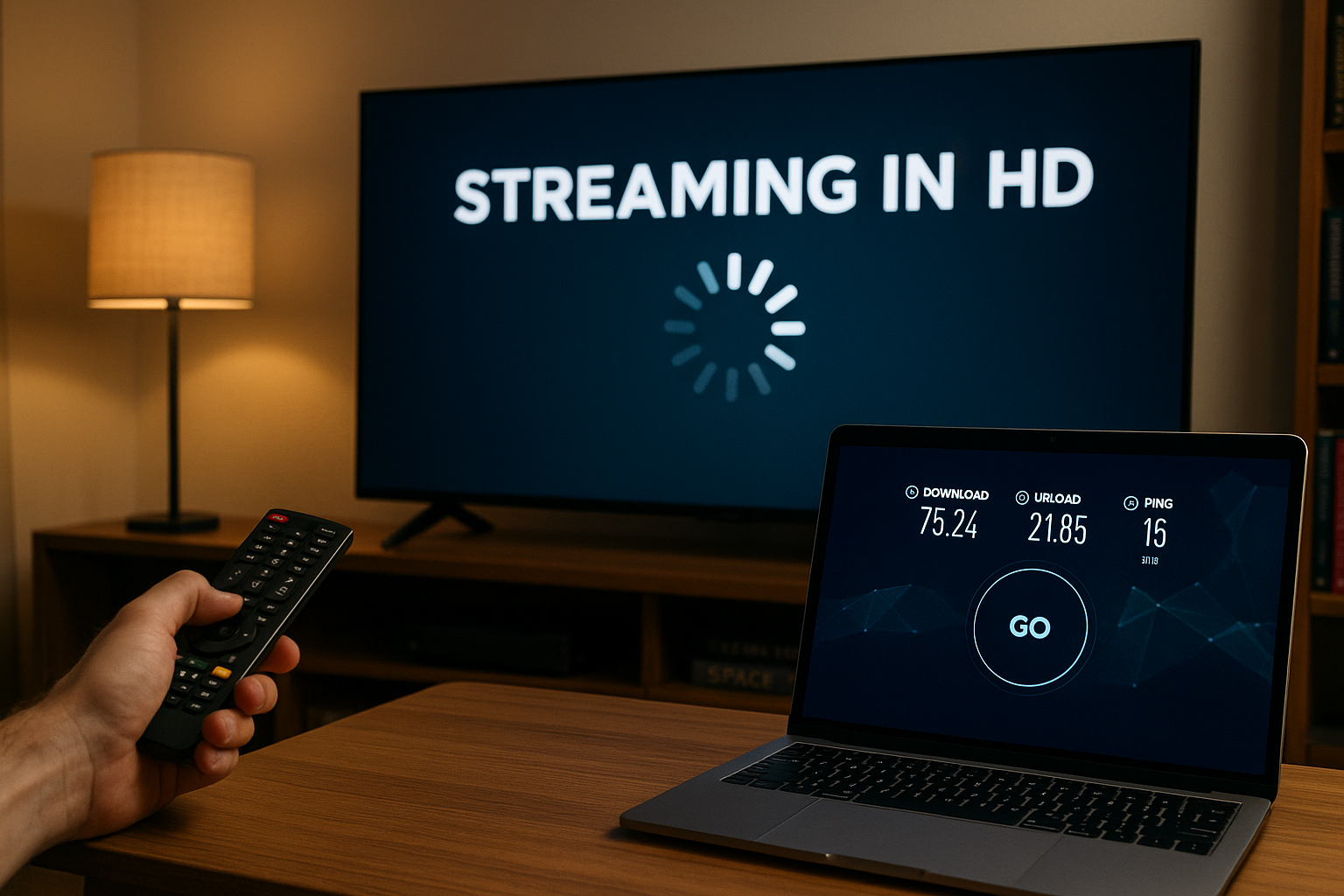Streaming in high definition (HD) should be smooth and enjoyable, but nothing ruins the experience faster than buffering.
You press play, and instead of watching your show or movie, you’re staring at a loading icon. This can be incredibly frustrating—especially if you’re paying for a high-speed internet plan.
In this guide, we’ll show you how to stream HD content without buffering by identifying the real causes and applying easy, practical fixes that work in any household.
What Is Buffering?
Buffering happens when the video you’re watching loads slower than it plays. Streaming platforms like Netflix, YouTube, and Hulu load content in small chunks ahead of time to ensure smooth playback.
If your internet can’t deliver the data fast enough, playback pauses until more of the video is loaded. The result: annoying interruptions that break your viewing experience.
How Much Speed Do You Need for HD Streaming?
Different platforms have different speed requirements. Here’s a general guide:
- Standard Definition (SD): 3 Mbps
- High Definition (HD – 720p/1080p): 5–10 Mbps
- Ultra HD / 4K: 25 Mbps or higher
These speeds are per device. If multiple devices are streaming or using the internet at the same time, you’ll need more bandwidth.
For example, two people streaming HD at once may need a minimum of 15–20 Mbps for smooth playback.
Step 1: Run a Speed Test
Before anything else, check your internet speed using a reliable tool like Speedtest.net or Fast.com.
Look for:
- Download speed: Should meet or exceed the recommended amount
- Upload speed: Doesn’t affect streaming, but matters for other users
- Ping/latency: Low numbers (<50ms) are better for consistent streaming
If your speed is well below what your ISP promises, it’s time to investigate.
Step 2: Improve Your Wi-Fi Signal
Many buffering issues aren’t caused by your internet plan, but by poor Wi-Fi signal in your home. Thick walls, distance from the router, and interference from other devices can weaken your connection.
Tips to fix this:
- Move your router to a central, open location
- Elevate it—don’t keep it on the floor or hidden
- Keep it away from microwaves, cordless phones, and metal objects
- Use the 5 GHz band for faster speeds (shorter range)
- Use the 2.4 GHz band for better coverage in large homes
If your home is large or multi-story, consider a mesh Wi-Fi system for seamless coverage.
Step 3: Use a Wired Connection
For the best performance, connect your smart TV or streaming device directly to the router with an Ethernet cable.
Wired connections offer:
- Faster speeds
- No interference
- Lower latency
- Stable streaming, even in 4K
If you stream often or have multiple users in the house, Ethernet is a game changer.
Step 4: Reduce Network Congestion
Streaming can be slowed down if multiple devices are consuming bandwidth at the same time.
Examples:
- Someone playing online games
- Video conferencing
- Cloud backups
- Smart cameras uploading footage
What you can do:
- Schedule updates and backups during off-hours
- Limit streaming to one or two devices during peak use
- Prioritize your streaming device using Quality of Service (QoS) settings in your router
Network management ensures that your streaming gets the bandwidth it needs.
Step 5: Lower Streaming Quality (If Needed)
If your connection is unstable or slower than usual, lowering video quality can help prevent buffering.
On most platforms, you can adjust video quality manually:
- YouTube: Click the gear icon, choose a lower resolution
- Netflix: Settings > Playback Settings (web only)
- Amazon Prime Video: Settings > Stream & Download
Even HD content still looks great on smaller screens, so this trade-off might not be noticeable.
Step 6: Update Your Equipment
Older routers or streaming devices can’t handle modern streaming demands.
Replace if:
- Your router is more than 4–5 years old
- Your device only supports Wi-Fi 4 (802.11n)
- You experience frequent disconnects or lags
Look for:
- Wi-Fi 5 or Wi-Fi 6 routers for faster performance
- Devices that support dual-band and the latest streaming apps
Also, check if your smart TV or streaming stick has firmware updates.
Step 7: Clear App Cache or Reinstall
If buffering happens on one platform or device only, the issue may be with the app itself.
Try:
- Clearing the cache
- Logging out and back in
- Uninstalling and reinstalling the app
This clears temporary data that may be corrupted and improves streaming performance.
Step 8: Upgrade Your Internet Plan (If Needed)
If you consistently stream on multiple devices and your speed test results show that you’re hitting your bandwidth limit, it might be time to upgrade.
Choose a plan that offers:
- At least 100 Mbps for HD and 4K streaming households
- Unlimited data to avoid throttling
- Symmetrical speeds if you also upload content or use video calls
Fiber-optic internet is ideal for streaming because of its low latency and high bandwidth.
Bonus: Use a Streaming Buffer Tool
Some advanced users use tools or browser extensions that pre-buffer large portions of the video, minimizing interruptions even on slower networks.
Just be aware that this may consume more bandwidth up front.
Final Thoughts: Smooth Streaming Is Within Reach
Streaming in HD without buffering is absolutely possible when your network is optimized. From checking your speed to improving your Wi-Fi and tweaking your router, small changes add up to a better experience.
No more pauses, no more frustration—just uninterrupted entertainment.

With over two decades of experience in the tech world, the author of Promoção InternetFibra is passionate about helping people improve their home internet. He specializes in networks, equipment, and performance optimization, turning complex tech topics into simple, practical advice. His mission is to make reliable, high-speed internet accessible for everyone.
